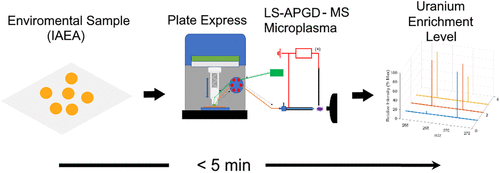Rapid Determination of Uranium Isotopic Abundance from Cotton Swipes: Direct Extraction via a Planar Surface Reader and Coupling to a Microplasma Ionization Source
Clemson University, Oakridge National Laboratory
Abstract
The collection of solid particulates and liquids from surfaces by the use of cloth swipes is fairly ubiquitous. In such methods, there is a continuous concern regarding the ability to locate and quantitatively sample the analyte species from the material. In this effort, we demonstrate the initial coupling of an Advion Plate Express plate reader to a liquid sampling–atmospheric pressure glow discharge (LS-APGD) microplasma ionization source with an Orbitrap mass spectrometer to perform uranium isotopic analyses of solution residues on cotton swipes. The Plate Express employs a sampling probe head to engage and seal against the swipe surface. Subsequentially, the analyte residues are desorbed and transported within a 2% HNO3 electrolyte flow to the ionization source. Quantitative recoveries were observed following a single 30 s extraction step, with the absolute mass sampled per extraction being ∼100 ng. While the intrasample variability in the analytical responses for triplicate sampling of the same swipe yield ∼30% RSD, this lack of precision is offset by the ability to determine isotope ratios for enriched uranium specimens with a precision of better than 10% RSD. Pooled, intersample precision (n = 9) was found to be <5%RSD across the various sample compositions. Finally, 235U/238U determinations (ranging from 0.053 to 1.806) were accurate with errors of <10%, absolute. The 234U- and 236U-inclusive ratios were determined with similar accuracy in enriched samples. While the driving force for the effort is in the realm of nuclear nonproliferation efforts, the ubiquitous use of cloth swipes across many application areas could benefit from this convenient approach, including the use of versatile, reduced-format mass spectrometer systems.

